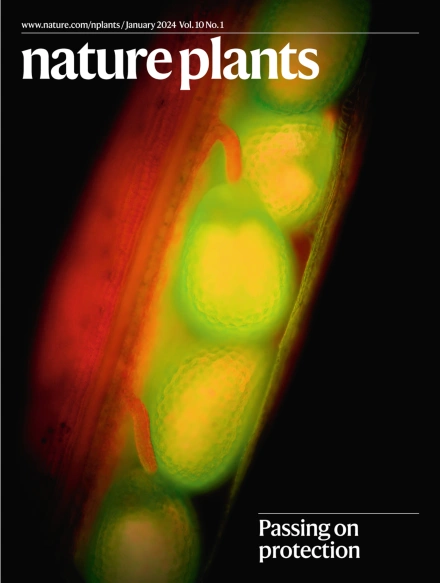Tomato ripening regulator SlSAD8 disturbs nuclear gene transcription and chloroplast-associated protein degradation.
IF 13.6
1区 生物学
Q1 PLANT SCIENCES
引用次数: 0
Abstract
Fruit ripening is a tightly regulated developmental process, in which nuclear gene transcription represents a crucial component of the mechanisms1. Chloroplast-associated protein degradation, a recently discovered pathway for chloroplast protein degradation, has also been reported to control fruit ripening2. Here we report a negative regulator of tomato ripening, termed SlSAD8, which disturbs both nuclear gene transcription and chloroplast-associated protein degradation. As an atypical stearoyl-ACP desaturase (SAD) protein exhibiting dual localization in plastids and the nucleus, SlSAD8 negatively regulates ripening initiation and chloroplast-to-chromoplast transition during fruit ripening. In the nucleus, SlSAD8 interacts with ripening-initiation-associated transcription factor SlNAM1, thereby disturbing the transcriptional activation of ethylene biosynthesis genes. Additionally, SlSAD8 interacts with plastid-transition-associated E3 ligase SlSP1 in the plastid, disturbing the chloroplast-associated protein degradation pathway to elevate chloroplast protein levels. Our findings uncover an unusual ripening regulator that targets distinct subcellular compartments to manipulate gene expression, providing insights into the intricate regulatory networks of fruit ripening.番茄成熟调节剂SlSAD8干扰核基因转录和叶绿体相关蛋白降解。
果实成熟是一个受到严格调控的发育过程,核基因转录在其中起着关键作用。叶绿体相关蛋白降解是最近发现的叶绿体蛋白降解途径,也被报道控制果实成熟2。在这里,我们报告了一个番茄成熟的负调节因子,称为SlSAD8,它扰乱核基因转录和叶绿体相关蛋白降解。SlSAD8是一种非典型硬脂酰acp去饱和酶(SAD)蛋白,在质体和细胞核中具有双定位,在果实成熟过程中负调控成熟起始和叶绿体到染色质的转变。在细胞核中,SlSAD8与成熟起始相关转录因子SlNAM1相互作用,从而干扰乙烯生物合成基因的转录激活。此外,SlSAD8与质体过渡相关E3连接酶SlSP1相互作用,干扰叶绿体相关蛋白降解途径,提高叶绿体蛋白水平。我们的发现揭示了一种不同寻常的成熟调节剂,它针对不同的亚细胞区室来操纵基因表达,为了解水果成熟的复杂调控网络提供了见解。
本文章由计算机程序翻译,如有差异,请以英文原文为准。
求助全文
约1分钟内获得全文
求助全文
来源期刊

Nature Plants
PLANT SCIENCES-
CiteScore
25.30
自引率
2.20%
发文量
196
期刊介绍:
Nature Plants is an online-only, monthly journal publishing the best research on plants — from their evolution, development, metabolism and environmental interactions to their societal significance.
 求助内容:
求助内容: 应助结果提醒方式:
应助结果提醒方式:


